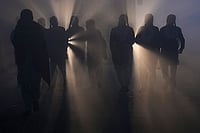A midst the roar of popular images of Hindu gods and goddesses in the style known as “Thanjavur paintings” that now flood the market, it’s almost a shock to discover the subdued richness of the originals.
They do not shout. They signal. They do not behave like garrulous tour guides crudely displaying nuggets of information for the entertainment of multitudes. They create multiple interpretations that call for repeated viewings. At times there is no explanation.
The Marg issue devoted to Thanjavur’s Gilded Gods examines the extraordinary journey of one collector, Kuldip Singh, an architect and town planner whose interest in the genre happened almost by accident. As Nayanjot Lahiri says in the introduction, Singh was at first reluctant to accept two Thanjavur style paintings that had been sent to him by a dealer. Gradually, he began to feel intrigued by them. “The paintings seemed to grow on me,” he reports. Soon, Singh asked to see more. Some four decades and over 350 paintings later, Kuldip Singh’s collection of “South Indian paintings”, including related specimens from the Mysore school and from Andhra, with an essay by R.G. Singh, has been recognised by scholars and museum conservators as being a unique record of one man’s passion. His home is at Bhogal, in one of the older localities of New Delhi, is a house-cum-museum.
In his own introduction, Kuldip Singh situates the paintings as central to the religious arts of South India. He is at the same time acutely sensitive to suggesting their inclusive nature. Explaining the reasons for not just sharing the images but creating a context for them by situating each one in a particular temple, or iconic space, that has been extensively researched by scholar Anna L. Dallapicolla, Singh sets out his plan. “The majority of scholarly works are primarily concerned with the aesthetic qualities of religious art; its function is less often analysed or commented upon. What follows below is an attempt to view and to analyse Thanjavur paintings as objects of worship and as an inspiration for devotion, and to understand their crucial position as a bridge between the ‘classical’ aesthetic and the development of ‘calendar art’ in the 20th century.”
What lifts the collection into the realm of a pilgrimage of words and images is Dallapiccola’s energy. There does not seem to be a single temple that she has not visited or painting that she has not studied. She is the ‘shakti’ in this enterprise who has merged her scholarship into each image Singh has collected with a brevity that manages to elevate each portrait into an icon.
Singh has the last word when he describes how the once grand paintings are now made into calendars. “Viewed from the side of the gods, it appears that they have transmigrated from the physical body of exceptional purity of the ancient dhruva bhera and have acquired an ephemeral paper body to become closer to their poor, selfless devotee, the common man. Thanjavur art is surely the bridge that enables this divine transmigration.”


























